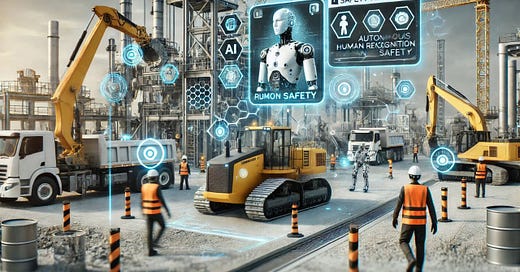Accidents Averted by AI
Imagine a Minority Report world in which potential accidents could be identified and prevented. Such a world is closer than you think.
It’s incredible to think about how much data we gather every day in construction. Not just on the machines we use but, increasingly, on the interactions between people and those machines.
For years, we’ve relied on advanced telematics to tell us everything about our equipment—the hours worked, fuel consumption, component wear. And that’s been game-changing. We can track performance so precisely that we know when a machine will fail before it even shows a sign of wear. It’s minimised downtime, increased productivity, and saved a fortune in repair costs.
But now, we’ve entered a new era with AI-driven human recognition software. It’s no longer just about the machines. It's about the people on-site and how they interact with those machines, how close they come to danger, and how often near-misses happen.
The ability to capture this data, to monitor health and safety incidents in real-time, has the potential to revolutionise the industry. Imagine: We can not only respond to accidents but actually predict and prevent them.
How?
By recognising patterns, analysing those near-misses before they become tragedies. The moment someone steps too close to a piece of machinery, the system could intervene or warn us before something catastrophic happens.
This isn't just about preventing accidents on individual sites, though that’s obviously critical. What we’re looking at here is much bigger.
If we took all that data—not just from one site or one organisation but across the entire industry—if we shared it, learned from it collectively, then we could truly change the way we work. We could redesign site layouts, rethink work processes, and improve safety protocols based on data, not just intuition or experience.
Here’s where the potential becomes transformational. What if the data from a site in, say, London, could benefit a project in Dubai? What if the lessons learned from an incident in Sydney could prevent a similar occurrence in San Francisco? The technology is here. We’re already gathering this data. We just need the will to share it, to collaborate across companies, regions, and countries.
Of course, there are hurdles. Data privacy, competition, even liability concerns. Sharing this kind of information across organisations would take trust and a major cultural shift.
Companies might worry about revealing vulnerabilities, about exposing mistakes. But we need to ask ourselves: Is that more important than safety? Is protecting our individual interests worth more than saving lives, preventing injuries, and improving working conditions for everyone in the industry?
There’s also the fear that if this data becomes widely available, it might be used against companies in legal proceedings. It’s a valid concern, no doubt, but if the alternative is continuing with the status quo—where near-misses happen, where accidents still occur at alarming rates—then maybe the benefits outweigh the risks.
Maybe we need to rethink how we view safety in the construction industry. Instead of hiding our flaws, maybe we should be open about them so we can fix them collectively.
And think about the ripple effect. With enough data, we wouldn’t just improve safety—we could drive innovations in everything from site planning to the design of machinery itself. Manufacturers could use the insights to build safer, smarter machines. Construction companies could use them to develop better training programs for their workers. And regulators could set standards based on real-world data, not just hypothetical models.
The thing is, we’re already at the tipping point. We have the technology. It’s not some far-off, sci-fi vision. The telematics, the AI recognition software, the ability to analyse and learn from this data in real-time—it’s here. We just need to decide how to use it. We need to ask ourselves: Are we willing to share this knowledge for the greater good? Are we ready to collaborate across the industry to create safer, smarter worksites?
We talk a lot about innovation in construction—about building taller, faster, more sustainably. But maybe the most important innovation we could adopt is a mindset of openness, of sharing what we know, not hoarding it. The opportunity is in front of us. We have the power to drive universal learning and improvement.
All we need is the will to do it.
This article was the subject of much discussion in the latest episode of The Recap, which you can listen to here.





